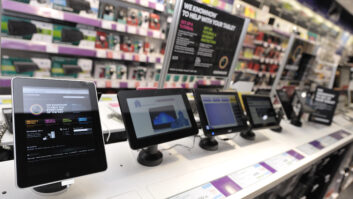Once again, HDTV dominated discussions and announcements relevant to the consumer electronics industry at the recent National Association of Broadcasters (NAB) convention.
The Consumer Electronics Association (CEA) used the occasion to announce that cumulative factory-to-dealer unit sales of DTV products surpassed the 5 million mark in February. CEA’s DTV sales figures represent integrated sets and displays.
The CEA reported unit sales of DTV products reached 241,279 as factory dollar sales totaled $409.2 million. When combined with DTV sales, since DTV products were introduced in the fourth quarter of 1998, total DTV sales tally 5,139,775 units and $9.3 billion.
CEA president Gary Shapiro said, “It is important to recognize that this momentum can only continue if all related industries and government officials continue to drive the transition forward.” He called on broadcasters to commit to getting DTV stations on the air in full power, adding that only 780 of the 1,304 commercial broadcast stations in the country are on-air in digital.
He also called on the Federal Communications Commission to quickly adopt the cable TV plug-and-play agreement reached last December to accelerate the delivery of cable-compatible DTVs.
The CEA, in association with the NAB and the Advanced Television Systems Committee (ATSC), presented a “DTV Drafthouse,” to showcase HDTV products and programming to showgoers. Other CE-related announcements at the show included the following:
ATI Technologies, based in Markham, Ontario, introduced a next-generation digital receiver chip called the Theater 310 for combined reception of digital 8VSB (over-the-air digital TV), 64 and 256 QAM (digital cable TV) and NTSC analog TV signals. The chip will be marketed to manufacturers of digital television receivers (DTVs), PC-DTV (personal computer-digital television), set top boxes, datacasting and integrated tuner demodulators (ITDs).
ATI said the Theater 310 will handle strong co-channel NTSC interference, burst noise, adjacent channel and single-frequency interference in addition to its multipath canceling capability. The company said the performance in the field has been improved over past NXT2000 chips.
Theater 310 samples and evaluation systems will available in the third quarter of 2003.
Canon’s Consumer Imaging Group demonstrated its “pro-sumer” DV camcorders, including the XL1S and GL2 models. Canon stressed the creative versatility and flexibility of the open architecture design in the two models by placing the camcorders in live, “real world” shooting environments at its booth. The company also announced a two-year limited warranty for a new XL1S. The offer, for eligible purchases made between April 1, 2003-June 30, 2003, from an authorized Canon dealer, extends the original Canon U.S.A. one-year warranty for an additional year.
Microsoft and LINX Electronics jointly demonstrated the first mobile delivery of high-definition (HD) programming over “an ATSC-like system.”
The new transmission technology together with the audio and video compression from Windows Media 9 Series enables broadcasters to reach mobile viewers with digital television (DTV) broadcasts.
The technology was demonstrated using a signal generated by a Sinclair Broadcast Group TV station reaching a van driving the streets of Las Vegas.
LINX Electronics transmission technology is said to broadcast mobile DTV signals through 6MHz channels using single-carrier VSB (Vestigial Side Band) modulation. Operating in a half-rate mode, the system provides an available payload of 9 Mbps, the company said.
Windows Media 9 compression technology delivers, at data rates as low as 5Mbps, HD video plus 5.1 channel surround audio streamed over the air from digital TV stations to televisions, PCs or other devices. High-quality HDTV can be achieved at one-third the bit rate required for MPEG-2, the companies said. The combination of the two technologies will transport standard definition (SD) video at rates as low as 1.5 Mbps.
The companies said their mobile technology “is particularly appropriate for countries that have not yet implemented DTV.”
Panasonic announced it will license HD Radio technology from iBiquity Digital to develop HD Radio receivers for digital AM/FM products, beginning with car radios in 2004. iBiquity Digital’s HD Radio technology allows radio broadcasters to transmit digital quality audio as well as integrated wireless data alongside their analog broadcasts. HD Radio digital receivers will receive these signals with improved audio fidelity that matches existing CD quality, the company said.













